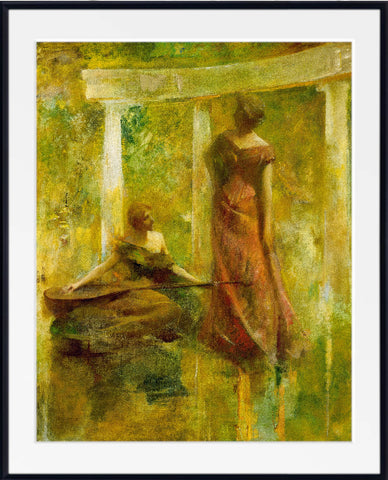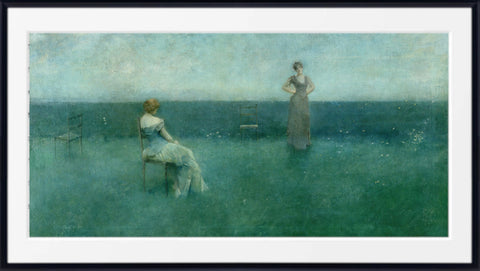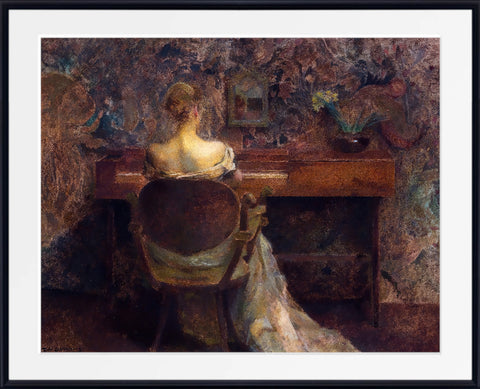Table of Contents:[hide]
Thomas Wilmer Dewing, an illustrious figure in the realm of American art, remains an enigmatic yet influential painter of the late 19th and early 20th centuries. Renowned for his exquisite figure paintings, Dewing's legacy is characterized by his adeptness in portraying aristocratic women in ethereal, dreamlike settings, encapsulating the essence of Tonalism. Let's delve into the life, works, and lasting impact of this remarkable artist.
Personal Life and Education
Born on May 4, 1851, in Boston, Massachusetts, to Sophronia Durant and Paul Dewing, Thomas embarked on his artistic journey at a young age. His early years were marked by apprenticeship as a lithographer, laying the foundation for his later artistic endeavors. However, it was his time at the Académie Julian in Paris, under the tutelage of Gustave Boulanger and Jules Lefebvre, that shaped his distinctive style. Dewing's academic training emphasized meticulous attention to form and texture, evident in his later works.
In 1880, Dewing relocated to New York, where he crossed paths with Maria Oakey Dewing, a fellow accomplished painter whom he later married. Together, they formed a formidable artistic duo, sharing a passion for art that transcended boundaries.
Career and Artistic Style
Dewing's artistic prowess manifested in his adeptness at Tonalism, a genre rooted in English Aestheticism. His preferred subjects—refined, aristocratic women—were depicted with a sense of detachment, inviting viewers to observe from afar rather than actively engage. The moody, dreamlike ambiance that permeates Dewing's works evokes a sense of introspection and tranquility, inviting viewers into a world of beauty and contemplation.
His notable piece, "Recitation," echoes the qualities of Pre-Raphaelite paintings, infused with the emotive depth reminiscent of James McNeill Whistler's oeuvre. This intersection of influences underscores Dewing's mastery in synthesizing diverse artistic elements into a cohesive, evocative whole.
Legacy and Recognition
Dewing's contributions to the art world were duly recognized during his lifetime. Elected into the National Academy of Design in 1888, Dewing's influence extended beyond his artistic output. As a founding member of the Ten American Painters, he played a pivotal role in shaping the trajectory of American art, advocating for artistic autonomy and innovation.
Despite painting less prolifically in his later years, Dewing's legacy endures through his extensive body of work, which continues to captivate audiences worldwide. His paintings adorn private collections and prestigious museums, with the Freer Gallery of Art at the Smithsonian Institution housing a dedicated collection in his honor.
Conclusion
In retracing the life and artistic journey of Thomas Wilmer Dewing, we unravel a tapestry of creativity, innovation, and enduring legacy. His mastery of Tonalism and his poignant portrayal of aristocratic women serve as testaments to his artistic genius. Dewing's legacy transcends temporal confines, inviting us to immerse ourselves in the timeless beauty of his creations and contemplate the profound depths of the human experience.
Thomas Dewing Prints and Canvas Panels
Prints and ready to hang canvas panels of Thomas Dewing's paintings are available in a range of sizes with fast worldwide delivery.
Thomas Dewing FAQ's
-
Who was Thomas Wilmer Dewing?
Thomas Wilmer Dewing was an American painter active during the late 19th and early 20th centuries. He was renowned for his contributions to Tonalism and his exquisite portrayal of aristocratic women in dreamlike settings.
-
What is Tonalism, and how does Dewing fit into this artistic movement?
Tonalism was a genre of American art rooted in English Aestheticism, emphasizing tonal harmony and atmospheric effects. Dewing's works epitomized Tonalism, characterized by his subtle yet evocative use of color and light to create mood and ambiance.
-
Where was Dewing trained as an artist?
Dewing received formal art training at the Académie Julian in Paris, studying under prominent artists Gustave Boulanger and Jules Lefebvre. His time in Paris profoundly influenced his artistic style, emphasizing academic precision and attention to detail.
-
What are some notable characteristics of Dewing's paintings?
Dewing's paintings often feature refined, aristocratic women depicted in serene, introspective poses. His figures exude a sense of detachment, inviting viewers to contemplate the scene from a distance. Moody lighting and subtle color palettes further enhance the ethereal quality of his works.
-
Did Dewing receive recognition for his artistic achievements?
Yes, Dewing was highly acclaimed during his lifetime. He was elected into the National Academy of Design in 1888 and was a founding member of the influential group, the Ten American Painters. His works received medals and accolades at various exhibitions, both nationally and internationally.
-
What is Dewing's legacy in the art world?
Dewing's legacy endures through his extensive body of work, which continues to inspire and captivate audiences. His contributions to Tonalism and his unique portrayal of feminine beauty have left an indelible mark on American art history.
-
Where can one view Dewing's paintings today?
Dewing's works are held in private collections and prestigious museums across the United States. The Freer Gallery of Art at the Smithsonian Institution houses a notable collection of Dewing's paintings, providing an opportunity for art enthusiasts to experience his mastery firsthand.
-
Did Dewing have any significant artistic partnerships or collaborations?
Yes, Dewing's collaboration with his wife, Maria Oakey Dewing, herself an accomplished painter, was integral to his artistic journey. The couple shared a passion for art and often spent summers together at the Cornish Art Colony in New Hampshire, fostering a creative environment conducive to their respective practices.
-
Why is Dewing's work still relevant today?
Dewing's timeless themes of beauty, introspection, and serenity continue to resonate with contemporary audiences. His ability to evoke emotion and contemplation through his paintings transcends temporal boundaries, ensuring his enduring relevance in the art world.
-
What resources are available for further exploration of Dewing's life and art?
For those interested in delving deeper into Dewing's life and art, numerous books, articles, and exhibitions offer valuable insights. Additionally, online platforms such as museum websites and art databases provide access to a wealth of information and resources related to Dewing's artistic legacy.






